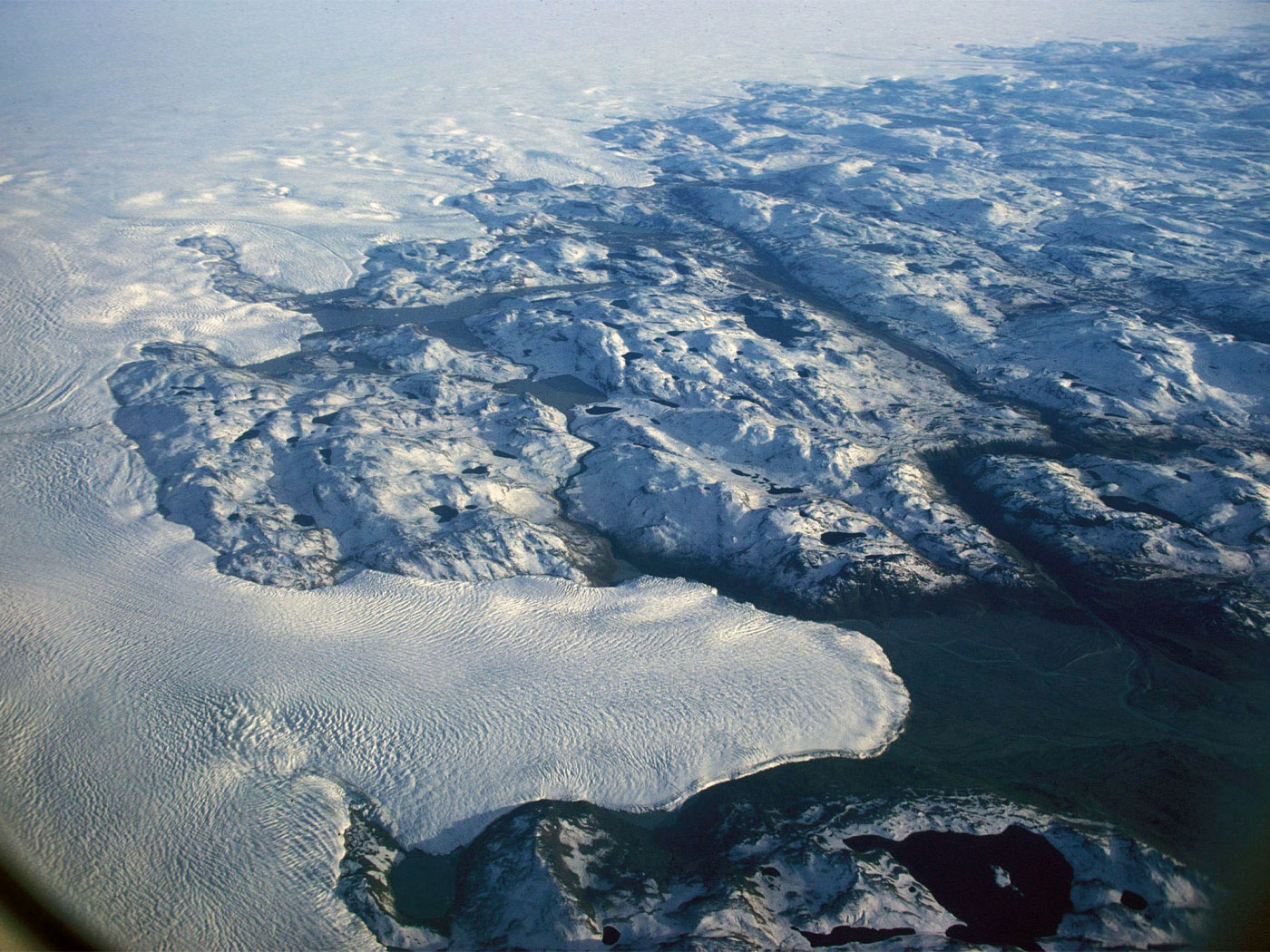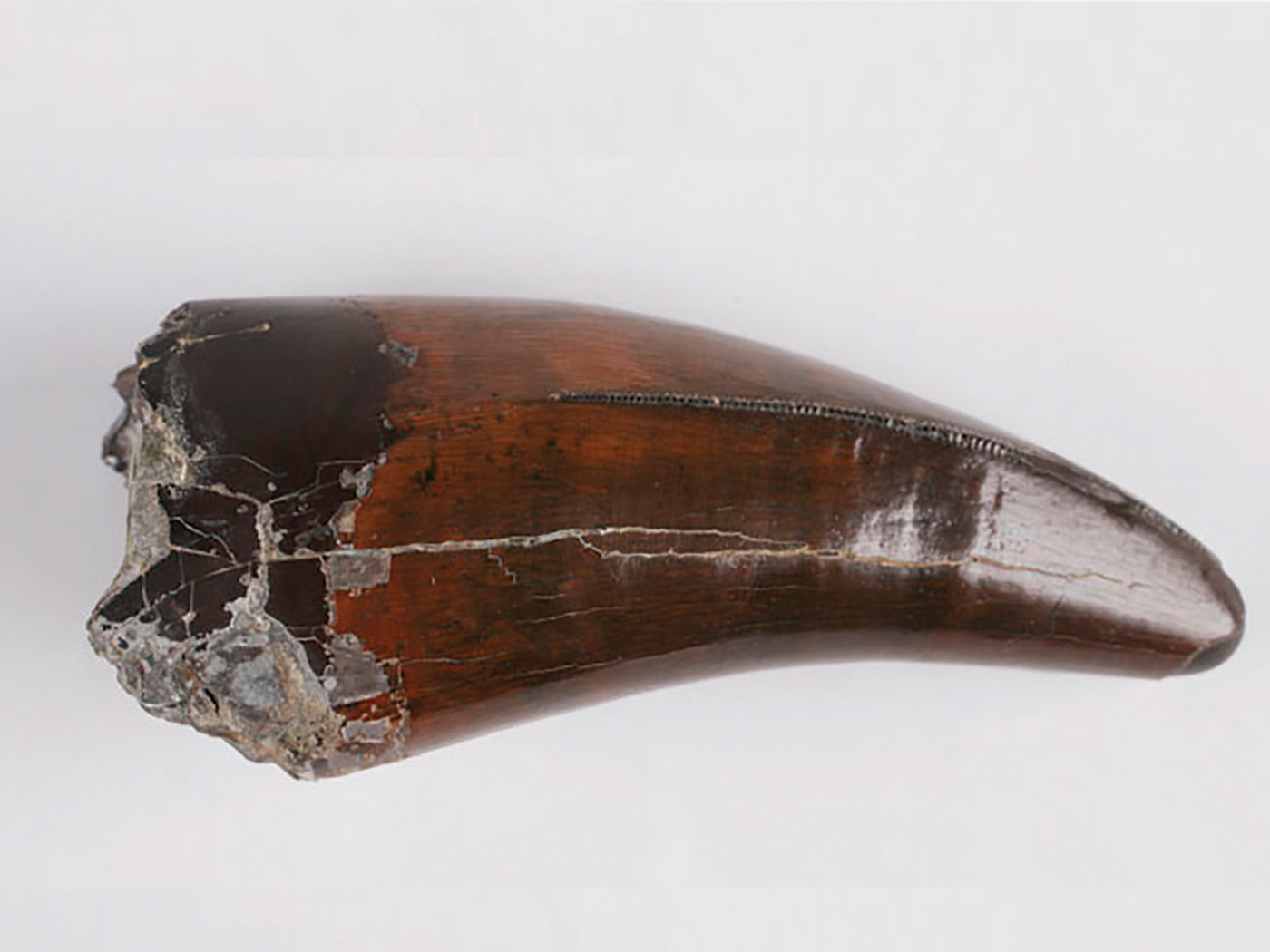“So easy, a caveman could do it” is the witty slogan of a company hoping to lure customers to switch car insurance. The humorous catch to the commercial was the brutish-looking, yet endearing, Neanderthals living among us who found the slogan stereotyping them as dimwits to be “not cool” or “hurtful.” The fact that viewers could readily spot the standard view of Neanderthals shows how pervasive it is and how it dominates the popular perception.
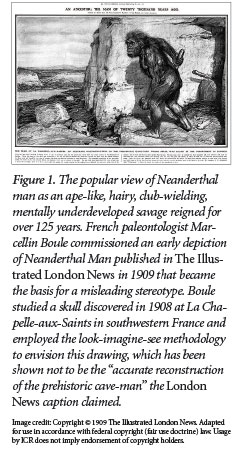 Evolutionary beliefs—not known facts about Neanderthals—forced this misleading subhumanized caricature of them. Evolutionary imagination conjured up the ape-like, hairy, club-wielding, mentally underdeveloped savage because it fit their expectations of a missing link between an ape-like ancestor and humans, as seen in Figure 1. Rather than liberating scientific research, for decades this major evolutionary blunder has sidetracked an accurate understanding of Neanderthals.
Evolutionary beliefs—not known facts about Neanderthals—forced this misleading subhumanized caricature of them. Evolutionary imagination conjured up the ape-like, hairy, club-wielding, mentally underdeveloped savage because it fit their expectations of a missing link between an ape-like ancestor and humans, as seen in Figure 1. Rather than liberating scientific research, for decades this major evolutionary blunder has sidetracked an accurate understanding of Neanderthals.
Imagining More Than Flesh on Neanderthal Bones
Charles Darwin hurt the scientific method when he injected the look-imagine-see methodology into the process of explaining the diversity of life on Earth.1 This method of interpreting findings has led to one evolutionary blunder after another in which evolutionists develop a clear mental picture of just exactly what they are looking for…even though it actually does not exist. The mental projections of ape-like features onto Neanderthal bones is akin to the envisioned ape-like features of the human skull cap of Piltdown man.2
Neanderthals were named after the limestone cave of the Neander Valley near Dusseldorf, Germany, where their first bones were discovered in 1856. Evolutionary ideas biased the interpretation of these bones just as these same ideas have prejudiced the understanding of different people groups found worldwide. Over 100 years later, the bestselling Life Nature Library series explained to lay audiences Neanderthals’ place in human evolution:
Darwin heard about these remarkable bones, yet never investigated them, but Huxley undertook a thorough study of the unprecedented skull. In the condition in which it was discovered, the cranium could hold 63 cubic inches of water; complete, it would have contained 75 cubic inches, or as much as the skulls of living primitive tribesmen.3
In the evolutionary spectrum of ape to modern human as reflected in brain size, “primitive tribesmen” were expected to fall somewhere in between.
Readers of this series in eight languages and in 90 countries were treated to more imagination than just the brain size of “primitive” tribesmen. Sir Julian Huxley was also able to clearly visualize ape-like features in the skull of this supposed transition from ape to human:
“Under whatever aspect we view this cranium,” wrote Huxley in 1863, in his book Zoological Evidence as to Man’s Place in Nature, “whether we regard its vertical depression, the enormous thickness of the supraciliary ridges, its sloping occiput, or its long and straight squamosal suture, we meet with apelike characteristics, stamping it as the most pithecoid [ape-like] of human crania yet discovered.” Neanderthal man, Huxley concluded, was more nearly allied to the higher apes than the latter are to the lower apes, but for all of that he was a man.3
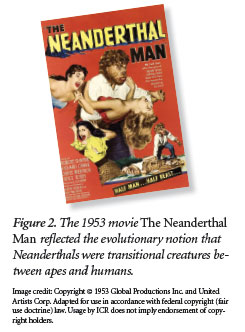 The view in scientific literature that Neanderthals fit into the evolutionary scheme as a type of transitional creature4 was reflected in the popular literature. Movies that today would seem like a spoof or a comedy, like the one advertised in Figure 2, shaped the public perception of Neanderthals and other “cavemen.”5
The view in scientific literature that Neanderthals fit into the evolutionary scheme as a type of transitional creature4 was reflected in the popular literature. Movies that today would seem like a spoof or a comedy, like the one advertised in Figure 2, shaped the public perception of Neanderthals and other “cavemen.”5
Evolutionary Depictions of Neanderthals Were Stunningly Wrong
In the last decade an astounding flood of documentation has poured in showing how Neanderthals are far more human than evolutionary stories have depicted.6 Views about diminished mental capacity were especially overturned. Infant brain development for Neanderthals was believed to follow “an ancestral mode of brain development, similar to that of our closest living relatives, the chimpanzees. Modern humans, by contrast, were suggested to follow a uniquely derived mode of brain development just after birth,” but “the new data indicate that Neanderthals followed largely similar modes of endocranial development to modern humans. These findings challenge the notion that human brain and cognitive development after birth is uniquely derived.”7
The full sequencing of Neanderthal DNA showed it was at least 99.7% like that of living humans.8 Neanderthals and other humans mated9 and exchanged DNA that “in some places, such as the DNA related to the skin, the genetic instructions are as much as 70 percent Neanderthal and in other places there’s virtually nothing from the species that’s often portrayed as brutish cavemen.” Therefore, the “next time you call someone a Neanderthal, better look in a mirror.”10
Usually creatures, especially humans, mate only with others that they recognize as the same species. The fact of Neanderthals mating with people like us reveals, as a science reporter states, that
“for a long time, the field of human evolution has imagined a fictional world where distinct human groups separated from one another and then remained distinct for long periods of time,” Siepel [a Cold Spring Harbor Laboratory geneticist said]….“And we’re just finding out on multiple time scales that’s just not true.”11
The evidence of Neanderthals as evolutionary transitions is being shown to be merely a mental construct that took on a life of its own following its wholesale adoption.
Possibly, the most remarkable findings are Neanderthal artifacts that reveal behaviors like those of all people throughout history. A simple search for published reports returns headlines like “Surprise: Neanderthals Were Fine Housekeepers,” “Ancient Engraving Strengthens Case for Sophisticated Neandertals,” “Ice age fashion showdown: Neanderthal capes versus human hoodies,” “The Real Question: Who Didn’t Have Sex with Neanderthals?,” “Neandertals may have used chemistry to start fires,” “Handaxe design reveals distinct Neanderthal cultures,” “Neandertals made their own jewelry, new method confirms,” “Maybe Neanderthals Weren’t Such…Neanderthals,” “Neanderthals Built Mysterious Stone Circles,” and “Modern humans no brainier than Neanderthals, study finds.”
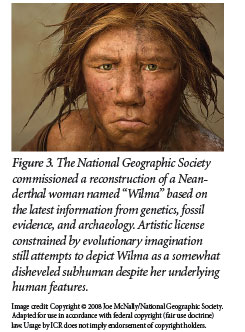 The magnitude of the evolutionary blunder that Neanderthals were transitions between ape and human is accentuated in today’s reconstructions of Neanderthals—which look like us. The National Geographic Society commissioned a reconstruction of a Neanderthal woman based on the most current information from genetics, fossil evidence, and archaeology, as shown in Figure 3. The magazine reported, “‘For the first time, anthropologists can go beyond fossils and peer into the actual genes of an extinct species of human,’ said National Geographic’s senior science editor, Jamie Shreeve, who oversaw the project.” It also reports “that at least some Neanderthals would have had red hair, pale skin, and possibly freckles.”12
The magnitude of the evolutionary blunder that Neanderthals were transitions between ape and human is accentuated in today’s reconstructions of Neanderthals—which look like us. The National Geographic Society commissioned a reconstruction of a Neanderthal woman based on the most current information from genetics, fossil evidence, and archaeology, as shown in Figure 3. The magazine reported, “‘For the first time, anthropologists can go beyond fossils and peer into the actual genes of an extinct species of human,’ said National Geographic’s senior science editor, Jamie Shreeve, who oversaw the project.” It also reports “that at least some Neanderthals would have had red hair, pale skin, and possibly freckles.”12
Given the currency of this blunder over Neanderthals, how likely is it that evolutionists would risk another mistaken depiction of a “caveman” sporting imagined features? It is clear that evidence for evolution obtained from fragmentary fossil remains must still be derived from Darwin’s look-imagine-see methodology. Another blunder concocted from fertile imaginations seems likely.
Another Imaginary “Authentic Look” at Early Human Life
Duke professor Adrian Bejan’s astute observation that “in biology, evolution is largely a mental construct built on imagination, because the time scale of animal evolution is immense relative to the time available”13 clarifies why holes in evolutionary theory get filled with “evidence” that is later shown to be pure fantasy. Neanderthals appear to be one variety of humans bearing traits that people today still express. But evolutionary theory for human origins still requires primitive transitional forms between apes and humans.
In 2009 the Public Broadcasting Service grabbed the human evolution baton and used its popular show NOVA to produce a three-part special on human origins, Becoming Human. NOVA retained the talented Graham Townsley as producer and Harvard paleoanthropologist Dan Leiberman as the technical consultant for human origins. They selected Homo heidelbergensis and Homo erectus to be depicted as subhuman links to an ape-like ancestor. Though fossil remains for both creatures are scarce, the program asserts that H. heidelbergensis is the direct ancestor of Neanderthals.
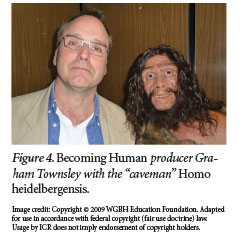 Just as French paleontologist Marcellin Boule invoked wholesale imagination in 1909 to depict Neanderthals as cavemen, NOVA and Townsley did the same with H. heidelbergensis. Filling the subhuman void left by Neanderthals, Figure 4 depicts NOVA’s actor made to look like a primitive caveman complete with a “pronathic lower jaw” and “protruding” lips.14 As costumed, he could star in either Becoming Human or the 1953 movie The Neanderthal Man. Fossils do not generally inform us of details about skin, hair, clothing, or behavior, thus Leiberman, like Boule, invokes pure imagination to advise on these features. NOVA’s documentary of the series’ production makes plain the imaginative element. “The skeleton of Homo erectus is different from a modern human,” it said, “so Townsley’s actors had to learn how to walk and run like an ancient hominin.” And Townsley describes how “Dan Lieberman, who is a well-known Harvard paleoanthropologist, is telling us all how he thinks we should go about imagining this hunting scene with Homo erectus.”15
Just as French paleontologist Marcellin Boule invoked wholesale imagination in 1909 to depict Neanderthals as cavemen, NOVA and Townsley did the same with H. heidelbergensis. Filling the subhuman void left by Neanderthals, Figure 4 depicts NOVA’s actor made to look like a primitive caveman complete with a “pronathic lower jaw” and “protruding” lips.14 As costumed, he could star in either Becoming Human or the 1953 movie The Neanderthal Man. Fossils do not generally inform us of details about skin, hair, clothing, or behavior, thus Leiberman, like Boule, invokes pure imagination to advise on these features. NOVA’s documentary of the series’ production makes plain the imaginative element. “The skeleton of Homo erectus is different from a modern human,” it said, “so Townsley’s actors had to learn how to walk and run like an ancient hominin.” And Townsley describes how “Dan Lieberman, who is a well-known Harvard paleoanthropologist, is telling us all how he thinks we should go about imagining this hunting scene with Homo erectus.”15
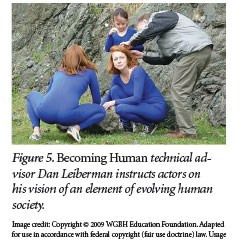 Becoming Human also conveyed scenes of an “evolving human society.” Filling in where H. erectus bones leave off, Dan Lieberman drew again on his imagination in the scene shown in Figure 5 to instruct actors in blue suits on how to squat like apes and pick nits from each other’s hair. The blue suits allowed for computer graphics artists to cover their bodies with hair and other primitive features. Townsley desired his lay audience to have a high level of confidence in Becoming Human’s imaginary scenarios, and he “says that working with computer graphics like this was new ground for him, but he hopes they will give viewers an authentic look at what early humans were like,” and also that “the recreations” in his documentary will have “a new type of authenticity to them.”16
Becoming Human also conveyed scenes of an “evolving human society.” Filling in where H. erectus bones leave off, Dan Lieberman drew again on his imagination in the scene shown in Figure 5 to instruct actors in blue suits on how to squat like apes and pick nits from each other’s hair. The blue suits allowed for computer graphics artists to cover their bodies with hair and other primitive features. Townsley desired his lay audience to have a high level of confidence in Becoming Human’s imaginary scenarios, and he “says that working with computer graphics like this was new ground for him, but he hopes they will give viewers an authentic look at what early humans were like,” and also that “the recreations” in his documentary will have “a new type of authenticity to them.”16
Time and truth go hand in hand. Decades from now, Becoming Human may have as much credibility as The Neanderthal Man movie or be lumped in with other major evolutionary blunders. Its misleading information about Neanderthals was not something that just happened or can be blamed on pop culture. It started with evolutionary scientists and the scenarios they envision using Darwin’s look-imagine-see methodology to fill in the missing data for their theory.
References
- Guliuzza, R. 2016. Major Evolutionary Blunders: Haeckel’s Embryos Born of Evolutionary Imagination. Acts & Facts. 45 (11): 16-18.
- Guliuzza, R. 2015. Major Evolutionary Blunders: The Imaginary Piltdown Man. Acts & Facts. 44 (12): 12-14.
- Moore, R. 1962. Life Nature Library: Evolution. New York: Time Incorporated, 130.
- Trinkaus, E. and R. H. Tuttle. Neanderthal. Encyclopaedia Britannica. Posted on britannica.com January 29, 2015, accessed October 27, 2016.
- Hadingham, E. Early Humans in Pop Culture. NOVA. Posted on pbs.org October 26, 2009, accessed October 27, 2016.
- For a comprehensive catalog of Neanderthal behaviors like those of humans living today see Neanderthal Concept Has Imploded. Creation Evolution Headlines. Posted on crev.info February 22, 2016; Neanderthals Underestimated Again. Creation Evolution Headlines. Posted on crev.info May 27, 2016; and O’Leary, D. A Deep and Abiding Need for Neanderthals to Be Stupid. Why? Evolution News and Views. Posted on evolutionnews.org July 21, 2014.
- Ponce de León, M. S. et al. 2016. Brain development is similar in Neanderthals and modern humans. Current Biology. 26 (14): R665-R666.
- Complete Neanderthal Genome Sequenced. National Institutes of Health News. Posted on genome.gov May 5, 2010, accessed October 27, 2016.
- Kuhlwilm, M. et al. 2016. Ancient gene flow from early modern humans into Eastern Neanderthals. Nature. 530 (7591): 429-433.
- How much Neanderthal DNA do you have? Lots. Associated Press. Posted on foxnews.com January 29, 2014, accessed October 28, 2016.
- Resnick, B. Humans and Neanderthals had sex. But was it for love? Posted on vox.com September 14, 2016, accessed September 27, 2016.
- Braun, D. Photo in the News: DNA-Based Neanderthal Face Unveiled. Posted on news.nationalgeographic.com September 17, 2008, accessed November 7, 2016.
- Bejan, A., J. D. Charles, and S. Lorente. 2014. The evolution of airplanes. Journal of Applied Physics. 116 (044901): 1-6.
- Levin, D. Depicting Our Ancestors. NOVA. Posted on pbs.org. October 26, 2009, accessed October 27, 2016.
- Ibid.
- Ibid.
*Dr. Guliuzza is ICR’s National Representative.





